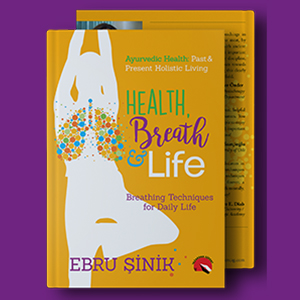 In this article series, I will share 10 different breathing techniques based on science. Your weight for your health and the effect you will have on your mind.
In this article series, I will share 10 different breathing techniques based on science. Your weight for your health and the effect you will have on your mind.
After reviewing all the breathing exercises in my book Health Breath Life by Ebru Sinik, you pick the four tecniques that you need the most for add to your routine.
We are as healthy and happy as we can manage stress, which is the biggest disease process of our age.
Creating space to be relevant to our body, to be real, is a prerequisite for health and our product.
Breathing Techniques are not belief systems. Whether you believe it or not, you will see the benefits as long as you practice it regularly because these are technologies, software programs that work in human physiology and all other bodies.
By applying pranayama exercises, which are controlled and rhythmic Breathing Techniques based on the knowledge of yoga, given through the nose;
• It can calm your mind
• It can create balance in all your bodies
• It can revitalize your body by evacuating inactive and sluggish energy.
• We can get rid of negative emotions, thoughts, belief patterns and toxins created by food.
 Main Principles and Warnings
Main Principles and Warnings
• Pranayama, that is, Breathing Techniques based on the science of yoga can never be practiced lying down.
• Never do exercises with a full stomach immediately after meals.
• The two most important issues while practicing Breathing Techniques are safety first and then a comfortable upright sitting. Wherever you prefer to sit; You should either sit cross-legged and comfortably on the floor or on a chair with a spine that is strictly upright, at a 90-degree angle.
• The mouth should be closed all the time, unless told otherwise, and only the nose should be used for breathing.
• The tip of the tongue should stay at the fire point unless otherwise stated. In other words, the tip of your tongue should be positioned comfortably just behind your front two teeth, touching the upper palate. This position of the tongue is very important to experience the benefits of breathing exercises. Your tongue here it should definitely not be tight, it should be relaxed.
• Release the neck and shoulders. Imagine the distance between your earlobe and your shoulders as far as possible and leave your shoulder blades relaxed.
• Eyes should always be gently closed during breathing exercises.
• Never force yourself, if you feel dizzy stop and return to your normal breathing mode. Because if you feel dizzy, it means you inhaled too much oxygen and hyperventilation has started, which is something we never want.
• If you feel any discomfort or pain while doing the exercises, stop immediately, return to your normal breathing and exhalation rhythm and rest with your eyes closed.
• Never exceed the recommended maximum number and duration of breaths and times.
• If you are just starting out with breathing exercises, only follow the recommended numbers and times for the first week until you are convinced that you are training.
• You don’t have to increase the number of breaths or their duration if you don’t need or want them over time. For all of them, you can stay within the recommended breath numbers for the first week and still continue to experience the benefits. Even if you feel that the recommended numbers for the first week are too much for you, you can apply it by decreasing to the number you want without leaving your comfort zone.
• Sitting by placing a slight elevation under your coccyx will increase your comfort while sitting cross-legged on the ground. You can also try this yoga block, a pillow at home, or a meditation pillow. Remember, it is very important to provide comfort with an upright sitting.
• Apart from the Kapala Bhati and Bhastrika breathing exercises, which are Fire Breaths, other techniques can be practiced while sitting on a chair.
While sitting on the chair, make sure that your kneecap and hip level are the same. If necessary, place an elevation under your feet.
• Breathing exercises are generally not applied in febrile diseases, bronchitis, lung inflammations and pneumonia cases, during women's menstrual period, after recent heart attacks during pregnancy. In such cases, attention should be paid to the list of contraindications specified before each breathing exercise and should be applied accordingly.
• In addition, Breathing Techniques should not be applied during chemotherapy and radiotherapy periods of cancer cases and in cases with extensive metastases, unless your doctor recommends it. In such cases, I recommend applying slow and simple diaphragmatic breaths that increase diaphragmatic awareness only while lying down.
• Breathing Techniques that increase the fire element are not suitable for children who have not reached the age of puberty.
• Also, don’t apply fire breathing techniques, which accelerate metabolism, close to your sleep time at night; It can cause insomnia as it will increase energy.
In our next series of articles, we begin to learn pranayama exercises based on the knowledge of yoga one by one.